While solar power is the dominant residential renewable energy source, wind power is another great option for homeowners looking to green their electricity footprint. According to a 2015 U.S. Department of Energy report, wind power provides nearly 5 percent of U.S. energy demand across 39 states. That’s a macro-level statistic, though. How about on the micro (family home) level? That’s where this guide comes in. Here you’ll find lots of helpful information on home wind power systems: what’s available, how it works, and how it stacks up against (and works with) solar.
Solar or Wind : Weighing the Differences
| Solar | Wind | |
|---|---|---|
| Source of energy | The sun is everywhere, although some places are sunnier than others. Geography and panel placement matter. | Wind is not everywhere, at least not enough to count on for power generation. With wind, geography matters even more than solar. |
| Space and Integration | Solar panels take up space but can be placed almost anywhere (roofs, ground, etc.) as long as they’re facing the sun. | Wind turbines are space-efficient, but placement can be a problem. They need to be located above and away from other buildings and obstacles and at height to take advantage of wind currents. |
| Cost | The average cost of a 5 kW system, (based on $3.70/watt) is approximately $13,000 after tax credits. | $30,000 on average for a 5 kW system, before federal tax credits, which would bring total costs total upfront costs to around $20,000. |
| Maintenance | Solar panels and systems have virtually no moving parts and require little maintenance. Parts should be inspected, panels cleaned, etc. on a periodic basis. | Maintenance needs vary greatly depending on turbine type. Operational costs are generally relatively low, but moving parts do require regular maintenance and replacement. |
| Warranty and System Lifespan | Warranty periods vary by manufacturer, but are commonly 25 years for panels, five to ten years for inverters, batteries. Solar panels typically last up to 30 years. | Warranty periods for turbine components vary by manufacturer, but five years is common. Systems can last 20-25 years, but will require parts to be replaced along the way. |
| Predictability and Reliability | Solar PV systems are extremely reliable. Predictability is difficult on a day-to-day basis, but highly predictable in the longer term. | Like solar, wind power systems are very reliable. Predictability of service can be tricky however, as wind generation often fluctuates significantly. |
| Noise | With no moving parts, solar PV systems are noiseless during operation. | Sound levels for most residential wind turbines manufactured today are only a little above the ambient wind noise. Placement near the home can result in enough noise to be bothersome at times. |
| Effect on Wildlife | Relatively low impact on wildlife, particularly in regard to residential solar systems. | Wind turbine movement can be a danger to wildlife, particularly to birds and other flying creatures. |
You need to know what it is that you want to accomplish. Are you trying to reduce your electric bill? Are you trying to eliminate your bill all together? Are you trying to run your house directly? Are you trying to solve some kind of battery backup, off-grid problem when the power goes out?

How Solar and Wind Power Work
It’s all about the sun, and that goes for both solar and wind power. Solar energy by definition comes from the sun. Solar panels then convert solar energy into electricity.
But what about wind? Wind energy is created by the uneven heating of the Earth’s surface. Warm air expands, becomes less dense and rises into the atmosphere. Cooler air then rushes in to take the warmer air’s place. And that movement of air is wind. Viola. Wind is caused by the sun.
But how then does wind energy get converted into electricity? Here’s how:
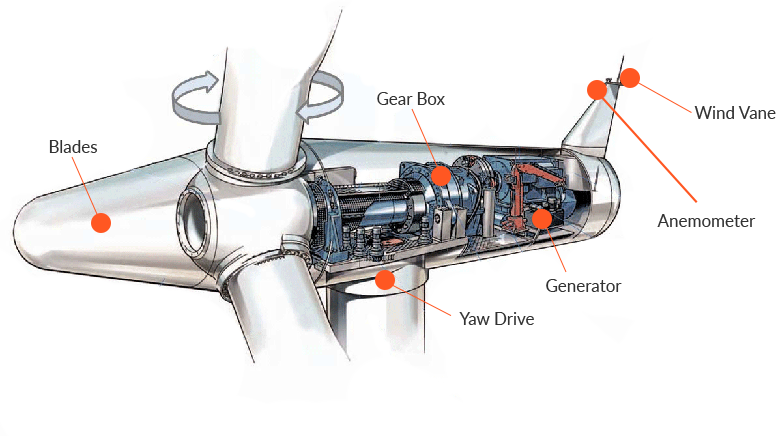
The anemometer measures and transmits wind speed to the system’s controller, which turns the turbine on or off based on the wind speed data.
As the wind blows though the blade field, the blades rotate causing the rotor to spin.
The gear box connects the low- and high-speed shafts, resulting in a rotational speed needed to produce electricity.
Inside the generator casing, the high-speed shaft connects to a magnet assembly that is surrounded by a coil of wire (conductor). As the shaft rotates, voltage is induced in the conductor, which in turn drives electrical current through power lines and out for distribution.
The wind vane measures the direction of the wind and informs the yaw drive to properly orient the turbine.
As wind direction changes, the yaw drive adjusts the turbine’s position to keep it faced into the wind.
But of course there’s more to it than just the turbine. Your turbine has to be able to deliver the electricity to your home:
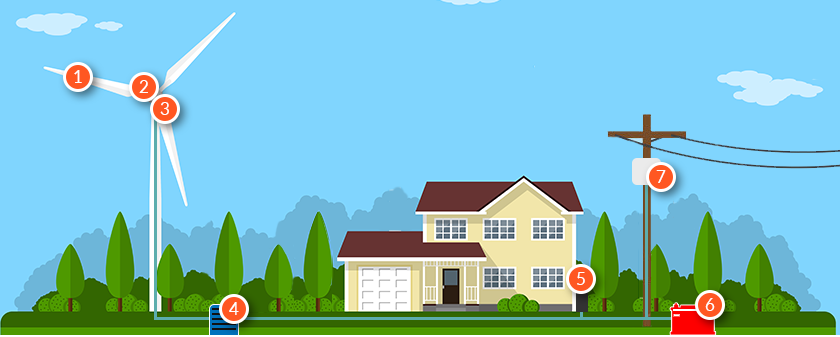
Wind passes over the turbine’s blades creating lift, causing the blades to turn and the rotor to spin.
The spinning rotor in turn spins the low-speed and high-speed shafts.
The spinning of the high-speed shaft in the generator induces voltage in the conductor, generating electricity.
The direct current (DC) travels to an inverter where it is converted into alternating current (AC).
The AC is then fed directly into the home’s power main to power lights and appliances, or…
…into a battery bank for storage, or…
…into a connection to the power grid and onto use by other energy consumers.
You can get power out of a solar system for 12 hours a day and you can [potentially] get power out of a wind turbine system for 24 hours a day. But you really have to live in a place where the wind really does blow that much.

Types of Solar Systems
There are three primary types of solar energy systems. Concentrating solar power, or CSP, uses the sun’s heat to drive electric turbines on a utility scale. The other two systems, solar heating and cooling (SHC) and photovoltaic (PV), are used both on residential and commercial levels.
Solar Heating and Cooling (SHC)

Water heating, space heating and space cooling account for a substantial amount of the energy consumed by the average household. SHC technologies can provide an affordable alternative to traditional gas and electric space heating and cooling systems in the home, as well as to heat water for use both inside the home and outside for swimming pools. SHC systems employ solar thermal collectors and use heat to create power rather than electricity. Solar thermal collectors include flat plate, air collector, evacuated tube, and trough.
Photovoltaic (PV)
Solar PV is the most common type of residential solar system as well as the type most people know about. Residential solar PV is the technology that takes energy directly from sunlight and converts that energy into electricity that is then used to power all of your electrical needs at home: heating, cooling, lighting, appliances, etc. For more information on solar PV, check out How Solar Power Works.
Types of Wind Systems
There are two primary types of wind turbine systems in use today: horizontal-axis turbines and vertical axis-turbines. Here’s a closer look at each:
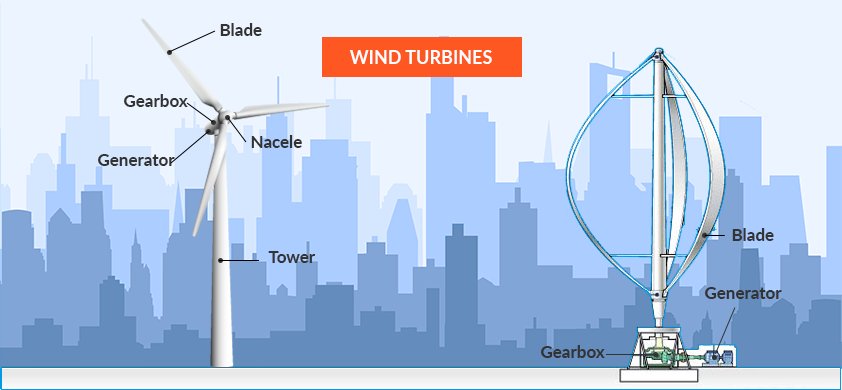
Horizontal-Axis Turbines
The majority of wind turbines today are horizontal-axis. If you’ve ever passed a wind farm, they’re the ones you saw with the rotor blades that look like the propeller on an airplane. According to the American Wind Energy Association, the average height of a small wind turbine (like one used for residential purposes) is approximately 80 feet, which is about twice the height of a neighborhood telephone pole.
-
Very efficient power generation, since the rotor blades move perpendicularly to always face the wind.
-
Tall tower takes advantage of greater wind speeds at the higher altitude.
-
Higher construction and installation costs. You’ve got to build a tower.
-
Placement can be a problem. They must be placed high enough and away from obstacles like trees and buildings to take advantage of unobstructed wind flow. Horizontal-axis turbines, therefore, are often an excellent choice in rural settings.
-
More moving parts, such as yaw control mechanisms, are required to turn rotor blades toward the wind. Additionally, braking devices are needed to stop the blades from turning in high winds to avoid system damage.
-
For some people, horizontal-axis systems are too loud and aesthetically unpleasing, a particular problem since they often can be seen for miles around.
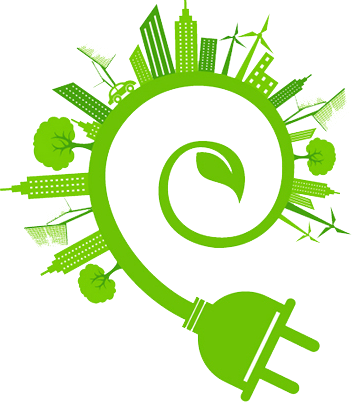
Vertical-Axis Turbines
Vertical-axis systems come in a variety of shapes, but the most common is the Darrieus turbine, which looks like two archery bows back-to-back. Vertical-axis turbines are difficult to mount on towers and therefore are normally mounted nearer their base on the ground or on top of a building.
-
Vertical-axis turbines do not need to be pointed at the wind to work properly, allowing the flexibility to place them in a greater variety of locations with varying wind directions.
-
You can mount them at lower heights, even on the ground. That means lower construction and installation costs, as well as easier and less expensive maintenance.
-
Installation at a lower height also means that vertical-axis turbines can be located where taller structures are prohibited by building codes.
-
Another advantage to lower location height? Vertical-axis turbines can be placed to take advantage of areas where the surrounding topography funnels the wind (thus increasing wind velocity) to the turbine’s location. This often makes them a better choice in urban settings when compared to horizontal-axis systems.
-
Vertical-axis turbines can operate in relatively low wind speed conditions.
-
Since a vertical-axis turbine does not require turning into the wind, no yaw mechanism is needed, which means less moving parts to maintain.
-
Lower placement means lower wind velocity in most cases. And even though vertical-axis turbines can operate with slower winds, it also means relatively low power generation.
-
The vertical blade design of a vertical-axis turbine results in increased drag when rotating into the wind, which means lower efficiency when compared to horizontal-axis turbines.
Sight & Sound: Solar Wins on Quiet
One way solar trumps wind power is in its silent, still operation. Where solar makes no noise or movement, wind turbines have generated complaints from residents nearby who report shadow flicker impact and constant noise. Here’s why:
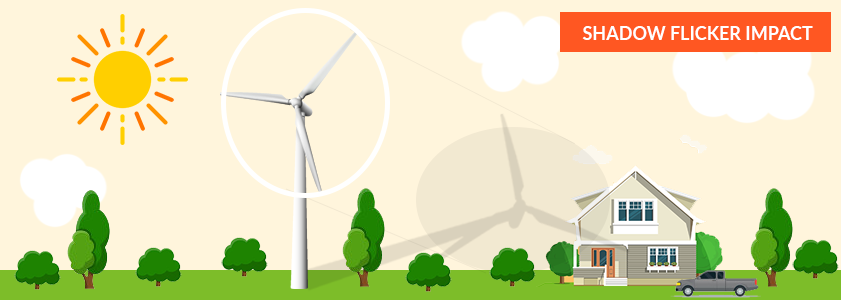
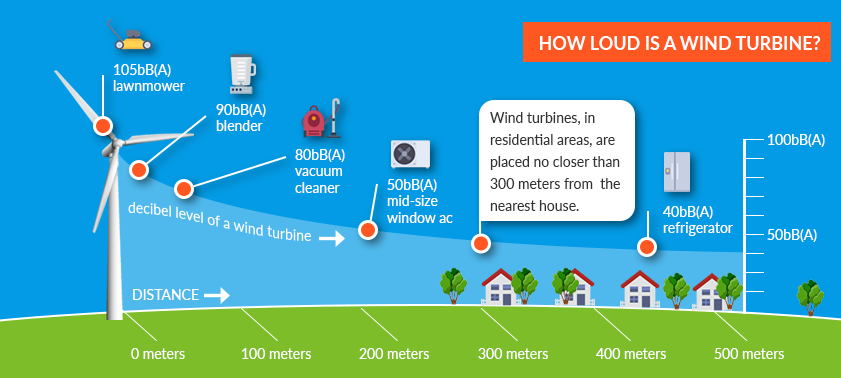
While smaller residential wind turbines are less likely to cause disturbance, it’s important to site all turbines correctly for maximum power and minimum disturbance.
The federal tax credit is a renewable energy credit that applies to both solar systems and wind systems at the same rate. We have state incentives here (Washington State), but those incentives are less for wind systems than they are for solar systems.

Solar and Wind Power: Comparing Costs
With all of the factors to consider, all of the advantages and disadvantages to solar, wind and other alternative energy resources to take into account, there’s one fundamental question everyone has about renewable energy systems: “What’s it going to cost?”

Let’s run the numbers on solar and wind systems providing electrical power for a typical household:
Solar
The total cost of a residential solar energy system varies substantially depending on several factors, including size of household, location, panel and accessory manufacturers, etc. Nevertheless, you should expect some steep upfront costs for the purchase and installation of any home solar system.
However, those steep upfront costs are substantially mitigated by a federal
government tax credit, through which the homeowner can claim a 30 percent
credit for qualifying expenditures on his or her purchase of a home solar
system. State and/or local incentives may also be available.
 10 kW Residential Solar Energy System
Average cost: $26,000
10 kW Residential Solar Energy System
Average cost: $26,000
Wind
Like solar, residential wind energy systems come with steep upfront costs. Economies of scale play a big role in the cost of wind turbines. Residential or small farm-scale turbine systems, for example, come with lower costs overall, but a higher cost per kilowatt of energy production capacity. According to U.S Department of Energy’s 2014 Distributed Wind Market Report, the average cost for turbines 2.5 to 10 kW in size (a 10 kW turbine, for example, is a reasonably sized unit for powering a large home) was $7,200 per kW, with small wind turbine installed costs trending downward.

| 2.8 MW Wind Turbine |
11 to 100 kW Wind Turbine |
2.5 to 10 kW Wind Turbine |
Less than 2.5 kW Wind Turbine |
|---|---|---|---|
| Average cost $6,230/kW ($17.44 million) | Average cost $6,000/kW ($600,000 for 100 kW turbine) | Average cost $7,200/kW ($72,000 for 10 kW turbine before tax credit) | Average cost $8,200/kW ($20,500 for 2.5 kW turbine) |
|
Large utility-scale turbine. |
A 100 kW turbine has the potential to generate 200,000 kWh per year, or enough for approximately 25 average-sized homes. |
Given the right wind sight, a 10 kW wind turbine could generate the energy needed for a large household. |
Wind turbines of this size can be used to generate enough energy for a small home or some, but not all, of the electricity used in the average household. |
Source for kW costs: U.S. Department of Energy: 2014 Distributed Wind Market Report (August 2015), p. i.
Installation: 5 Steps to Solar Power
The source of energy for solar PV systems is, of course, the sun, and the efficiency of a PV system depends on the amount of sunlight its panels are exposed to. It should be no surprise, then, that the best locations in the U.S. geographically for solar PV are in the southwest. What a lot of people don’t know, however, is that PV systems can work with exposure to both direct and scattered sunlight. So, if you live in a part of the country other than the southwest, solar PV may still be a great choice for your home energy needs. There are also site-specific factors to consider such as obstructions to sunlight exposure (trees, buildings, etc.).
We’ve discussed the subject of average household energy consumption needs throughout this guide. Suffice here to say that a very small home may be able to get by with 2 to 2.5 kW of energy generation, while a large residence might need as much as 10 kW of energy generation. To determine your needs, start with your monthly energy bill and your average daily usage, then add 25 percent to that daily average to compensate for the fact that your solar PV system will not run at maximum efficiency at all times (due to inclement weather conditions, for example.)
Start by figuring out your home’s hourly energy requirement and then divide that amount by the wattage generated by the individual solar panel. That will give you the number of panels you will need. How much wattage does a solar panel generate? Here’s where it gets a little tricky. The wattage varies by panel model, ranging from 150 to 345 watts per panel, generally speaking. You may want to make a series of calculations for a number of panel wattage ratings.
You’ve gathered up plenty of good information, but you are still going to need a detailed evaluation of your property, energy requirements, and equipment and installation costs. And that’s going to require an assessment from a professional installer. In fact, you should probably get assessments from a number of installers. Factors to consider include:
- Experience: With the solar industry booming, there are a lot of people out there calling themselves “professional installers,” but have little or no real solar installation experience. Make sure yours does by insisting that he or she show you proof of previous work and happy clients.
- Licenses and Insurance: Be sure that any installer you consider is fully licensed (general contracting, electrician, etc.) by the state. Also make sure that your installer is properly insured.
- Certification: Not all installers, not even all reputable installers, are certified. Nevertheless, look for installers with certification from a respected certifying agency like the North American Board of Certified Energy Professionals (NABCEP).
Be sure you read and understand all warranties associated with your system’s equipment and installation. For example, most reputable manufacturers today offer a 20- to 25-year warranty on their solar panels. Also, require your installer to warranty his or her work. Typical installer workmanship warranties range from one to 10 years.
The only maintenance required on a solar system is keeping the panels clean. We recommend to customers that they have their panels washed twice a year. In our area, there are window washing services that will come out and wash a customer’s solar panels for around $100 a visit. So if you clean your panels twice a year, that’s $200. For a wind turbine system, you’ve got moving parts that must be kept lubricated and have to be maintained. I have a couple of big wind turbines that we have installed and I charge them $495 twice a year to grease the fittings on the wind turbine. So, it’s basically costing them around $1,000 a year for maintenance compared to a solar system costing $200 a year.

Installation: 5 Steps to Wind Power
You need wind to generate electricity with a wind turbine, and not just any old wind will do. It has to blow at a high enough level and on a consistent enough basis to ensure the turbine’s cost effectiveness. Wind levels can be extremely site-specific, varying substantially within very short distances. To determine your wind potential, try consulting wind resource maps, like this one from the Department of Energy, obtain wind speed data from a nearby airport, or monitor your site by purchasing a direct monitoring system.

The specific site placement of your wind turbine on your property is extremely important. The best option is placement in a location that is flat and open, and with solid wind from at least one direction. But placement must also take into consideration other factors such as how tall the turbine’s tower must rise to take advantage e of optimal wind currents. Site possibilities include:
- Coastal/Lakeside Placement as close as possible to an ocean coastline or the shore of a lake, with trees or other tall structures downwind, is often optimal.
- Ridge TopsRidge tops are often an excellent location for turbine placement due to the compression of winds as they blow over the top of the ridge.
- Plateau/MesaTurbine placement too close to the cliff of a plateau or mesa can result in wind shear problems caused by turbulent winds running off of the cliff. Therefore, placement away from the edge of cliffs is recommended.
There are likely to be a number of permitting and zoning issues involved in the installation of a residential wind turbine system, particularly in urban and suburban areas. You should always be sure to have a clear understanding of these issues prior to the purchase of your equipment. Information regarding permits and zoning can normally be obtained from your local building inspector or by contacting your city or county government.
Additionally, installation of your wind turbine may be restricted by neighborhood or homeowner’s association covenants. In most cases, such covenants will cover issues of height, noise and/or aesthetics. Be sure you are aware of any such covenants that apply to your property.
It is also a good idea to consult with your neighbors to let them know your intent to install a wind turbine on your property. This will build good will and help to avoid any potential legal entanglements later on.
In most locations, you will have the option of either using your wind turbine as a stand-alone power source or connecting your turbine to the existing electric utility in your area. The biggest advantages to a grid-connected system are: you can get your electricity from the utility when there’s not enough wind to for your turbine to generate power, and; federal regulations require your local utility to purchase the excess electricity generated by you during those times when the turbine is producing more power than needed to in your home. The main disadvantage to grid connection is that you will have to shut down your turbine during outages due to safety issues.
Connecting to your local power grid can be expensive, so you should always determine whether or not a grid-connected system makes economic sense.
If you haven’t done it already, now is the time to contact one or more turbine manufacturers and/or local turbine installers. Manufacturers will provide you with detailed information on their latest turbines and related hardware, while installers will come to your property to assess it for wind potential, turbine size and other important elements. For factors to consider when choosing a wind turbine professional, see Step 4 of “Installation: 5 Steps to Solar Power,” above.
I go to a couple of conventions every year and I talk to people from all over the country, and the story is the same – you’ve got really good, professional, experienced, high-quality solar companies, and then you’ve got businesses that sell aluminum siding and windows that are now selling solar systems who really don’t know what they’re doing. So make sure you are dealing with a company that’s been around a while and has designers who have been designing solar systems for more than a few weeks.

Wind Turbine Manufacturers
- Founded: 1999
- Where it operates: U.S., Europe and parts of Latin America.
- What size turbines: 20 kW and 25 kW.
- Founded: 1986
- Where it operates: U.S. and around the world.
- What size turbines: 1 kW to 50 kW
- Founded: 1989
- Where it operates: Internationally.
- What size turbines: Up to 1 kW.
- Founded: 1986 (approx.)
- Where it operates: U.S. and around the world
- What size turbines: Less than 1 kW to 10 kW, plus commercial- and utility-scale
- Founded: n/a
- Where it operates: U.S. and Europe
- What size turbines: 6.5 kW
- Founded: 1980
- Where it operates: U.S. and around the world
- What size turbines: 1 kW to 10 kW
- Founded: 1976 (approx.)
- Where it operates: U.S. and around the world
- What size turbines: Less than 1 kW to 6 kW
- Founded: 1989
- Where it operates: U.S. and around the world
- What size turbines: 11 kW to 500 kW
- Founded: 1992
- Where it operates: U.S., West Indies and Asia
- What size turbines: Less than 1 kW to 5 kW
- Founded: 1999
- Where it operates: U.S. and around the world
- What size turbines (in kW): Less than 1 kW
- Founded: 1993
- Where it operates: U.S. and around the world
- What size turbines: 11 kW
- Founded: 2006
- Where it operates: U.S.
- What size turbines: 10 kW and 35 kW
- Founded: 2006
- Where it operates: U.S. and around the world
- What size turbines: Less than 1 kW to 3.5 kW
- Founded: Late 1960’s (parent company)
- Where it operates: U.S. and around the world
- What size turbines: 3.2 kW and 6.1 kW
- Founded: 2002
- Where it operates: Worldwide
- What size turbines: 1.5 kW
- Founded: 2004
- Where it operates: U.S. and around the world
- What size turbines: 10 kW
- Founded: n/a
- Where it operates: U.S. and around the world
- What size turbines: 1.5 kW, 3.5 kW and 7.5 kW
- Founded: 1968
- Where it operates: Throughout the U.S
- What size turbines: 10 kW to 20 kW
- Founded: 2009
- Where it operates: U.S. and Europe
- What size turbines: 2.1 kW
FAQs: Wind Power vs. Solar Power
Yes. In fact windmills have been used to pump water on ranches and farms for centuries, and it is estimated that there are around one million windmills pumping water today. A small number of companies currently manufacture wind turbines for pumping water.
Residential solar PV systems are actually relatively simple to understand and, more importantly, to operate and maintain once they are installed. Wind turbine systems have more moving parts and require some level of sophistication to repair, but in most cases repairs should be handled by experts anyway. In short, residential solar and wind systems should not present much of a problem for customers who do not consider themselves “high tech” savvy.
Net metering refers to the practice of placing excess electricity produced by a renewable energy source, such as your residential solar or wind power system, into your local utility’s power grid. Customers are then charged by the utility only for electricity generated by that utility and used by the consumer minus any electricity generated by the consumer and placed into the utility’s power grid. If the consumer adds more electricity to the grid than he or she consumes utility-produced electricity, the consumer may actually be paid by the utility for that excess energy.
A residential solar/wind hybrid power system combines a solar PV system with a wind turbine system to provide the consumer with a more consistent and reliable electricity source. If you can generate some, but not all, of your electricity needs from solar and some, but not all, of your energy needs from wind, then combining the two may allow you to generate all of the power you need. Solar/hybrid systems are often used by consumers who wish to remain totally “off-the-grid”.
Yes, solar installers generally will need to make holes in your roof as part of the panel installation process. However, the number of holes required is likely to be smaller than you think, and more importantly, modern installation techniques are designed to prevent any leaks from occurring from holes. This is another good reason to seek out a reputable, experienced installer for your system.
“Community wind” refers to wind turbine projects that, “incorporate local financial participation and control.” They are typically projects that are owned by local businesses, schools, farmers or others groups for the purpose of reducing community energy costs. Community wind projects commonly range in size from a single turbine to a commercial-scale wind farm.
The only real answer to the question is: “Beauty is in the eye of the beholder.” Aesthetics is often an issue when it comes to home renewable energy systems. You can bet, however, that homeowners who are saving big on their energy bills by using solar and wind power think their systems are beautiful.
Resources
The AWEA bills itself as the, “premier national trade association that represents the interests of America’s wind energy industry.” Features on this website include an excellent research and data page, as well as educational information on the basics of wind power.
The CESA is a nonprofit coalition of public agencies and organizations working to advance clean energy. Of particular note is this site’s resource library offering dozens of articles and more on all forms of renewable energy sources.
DSIRE’s site provides a comprehensive search engine that allows users quickly to locate renewable energy incentive plans, both federal and state. Sponsored by the U.S. Department of Energy, the NC Clean Energy Technology Center and North Carolina State University.
The DWEA is an association of manufacturers, distributors, developers, dealers, installers and others focused on all aspects of the distributed (small and community) wind energy industry.
Comprehensive U.S. Department of Energy resource for homeowners interested in learning more about residential solar PV systems.
Companion to Energy.gov’s solar site listed above. Includes links to other Department of Energy pages on subjects such as planning a home wind electric system and hybrid wind and solar electric systems.
This page provides access to tons of helpful information and data on government climate and energy programs. Included are government publications, newsletters, webcasts, energy calculators and more.
Excellent resource on a wide range of renewable energy sources including solar, wind, ocean, geothermal, hydropower and bioenergy. Visitors can access lots of informative statistics, charts and reports on all forms of renewable energy.
The NREL, “develops clean energy and energy efficiency technologies and practices, advances related science and engineering, and provides knowledge and innovations to integrate energy systems at all scales.” Its “Learn About Renewable Energy” page offers useful information of various renewable energy types including solar and wind.
The NABCEP is a provider of professional certification and company accreditation programs to renewable energy professionals throughout North America. Included on this site is a search engine for locating certified renewable energy installers for both solar and small wind systems.
The SWCC is an independent certification body that certifies wind turbines meeting specified organizational standards. This sites consumer section allows visitors to compare SWCC Certified small and medium wind turbine models.
The SEIA is a national trade organization dedicated to advocacy and education regarding the development and benefits of solar power. Visitors can use the site’s National Solar Database to locate solar energy-related businesses throughout the U.S.
SEI is a nonprofit educational organization providing, “technical training and expertise in renewable energy to empower people, communities, and businesses worldwide.” Its website offers access to online workshops and courses for those interested in solar PV and other renewable energy sources.
WINDExchange is the DOE’s platform for disseminating “credible information” about wind energy. Excellent source of data about wind resources throughout the U.S., including a series of useful national wind maps.
The WEF is a nonprofit organization whose goal is to raise, “public awareness of wind as a clean, domestic energy source.” The website is a comprehensive source on how wind energy works, wind power history and U.S. wind facts.


